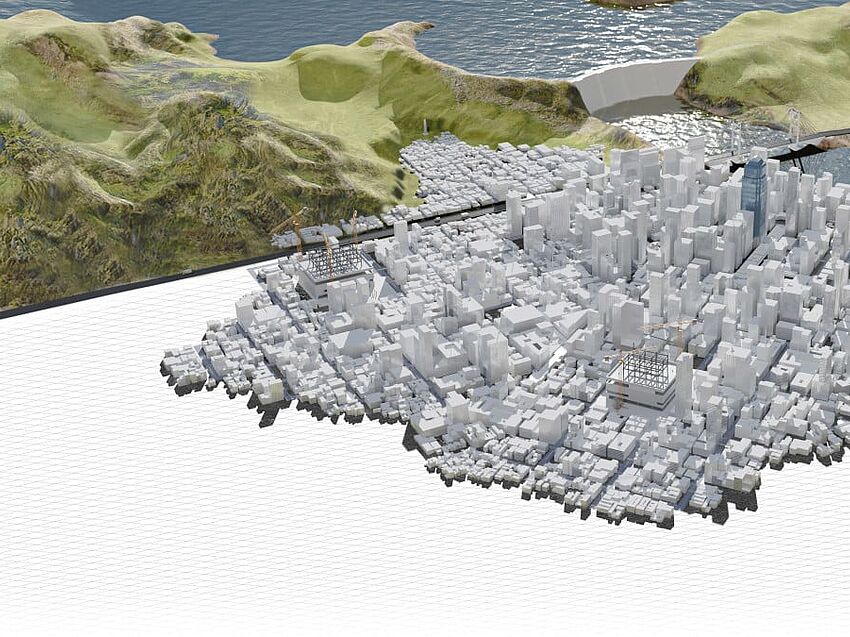Building Information Modeling (BIM) programs have been widely used by engineering and architecture firms in the United States for many years. Despite its relatively slow adoption into US-based projects, today BIM software is nearly accepted as the industry norm. The rising influence of this revolutionary approach has shaken the entire AEC industry, from company boardrooms to state legislatures. So, how will the increased adoption of digital workflows and 3D design and construction software shape the future of building?
A Slow Beginning
BIM was not always the widely accepted method of design and construction that it is today, especially in the United States. In fact, the adoption of BIM in North America was slow and plagued by red tape from the start. This is despite a conceptual foundation of the technology and approach being envisioned by American engineer Douglas C. Engelbart in 1962. In his paper Augmenting Human Intellect, Engelbart imagined the future architect and described the use of technology that would today be referred to as BIM. However, this vision was not brought to life until the 1980s, when several systems were developed in England and tested on various projects. As time passed, the development of the system would continue to make steady progress. But the US waited for significant advancements in computing and wider adoption by foreign governments before it became commonplace.
The motivation for developing BIM came out of a common need for solving an age-old problem experienced by architects and engineers alike. Drawing a two-dimensional object on paper causes a lot of issues when it must be converted into its real-world three-dimensional form. Added to this was the inherent inefficiency of hard copy drawings. Unsurprisingly, paper deteriorates over time and during the construction process cannot be quickly updated to reflect changes in design and construction.
With this problem fresh in the mind of developers and the golden age of computing well upon us, government departments, as well as tech companies, began to recognize the inherent value of computer-aided design in construction. Investments into the further development of BIM rapidly increased its use on active projects and afforded measurable increases in efficiency on the job site.
Even the US military took interest, as the Defense Advanced Research Projects Agency (DARPA) funded numerous projects for furthering its advancement. By the 1990s and early 2000s, computing had progressed enough to create a viable commercial option for use on private construction projects. Over time, BIM began to take root as an accepted standard and momentum gathered for government bodies to enact a legal mandate for its use on public projects. In the US, the most notable mandates were in 2006, on all contracts offered by the US Army Corps of Engineers, and in 2009, on all publicly funded structures in Texas and Wisconsin.
Utilization of BIM in the US Today
Today, the impact of BIM on the architecture, engineering, and construction industry in the US is immense. According to the American Institute of Architects (AIA’s) 2020 Firm Survey Report, 100% of large-sized architecture firms now utilize the methodology, and nearly 33% of smaller firms participate as well. This rise in usage coincides with the need to deliver ever-complex projects on time and under budget. All this is in addition to the growing legal pressure for BIM utilization on publicly contracted projects in a growing number of U.S. States. As the world continues to learn more about computers for digital design, this number is only expected to grow.
However, an important distinction to make is that BIM is not mandated on a federal level in the United States. To date, there is no requirement for public-sector projects to use the technology, which is very much in contrast to countries such as the UK and Singapore which have strict encompassing guidelines on its use.
The methodology has been adopted by US firms largely for its benefits in efficiency, reducing material waste, and improving site safety, rather than by legal requirement. While there is a large push to federally mandate its use in public projects costing over $5 million USD, the US does not have a central government department responsible for presiding over infrastructure and civil engineering projects. This may be one reason for its delayed adoption nationally.
Industry Impact of BIM Methodology
Despite its humble beginnings, BIM has taken a secure foothold in major projects throughout the country. While BIM is commonly used in larger projects, such as civil engineering and infrastructure ventures, its use in private building contracts and even home construction is increasing as the benefits of adoption grow and cost decreases.
Positioning itself as a cornerstone requirement for building, engineers and architects have been able to push the limits of design while still delivering on time. This was most notably illustrated in the One World Trade Center (also known as the Freedom Tower) in New York City. At 1,776 feet tall and designed almost entirely with 3D modeling, its sheer size and operational requirements make it one most complex building projects ever completed in the US.
© Shutterstock / Prin Adulyatham,
The One World Trade Center in New York City

Undoubtedly, BIM has been one of the most influential changes within the US construction industry in recent history. Advancements in BIM now allow architects and engineers to plan, design, and build a project virtually before the first ground is broken on site.
Supporting the Future of Construction
At ALLPLAN, we strive to bring our clients the best in state-of-the-art 2D and 3D modeling construction software. Through rigorous testing and worldwide application, our solutions have been at the forefront of digital communication and information sharing, with solutions such as Bimplus by ALLPLAN. This is in addition to our developments in clash detection, precise widget modeling, and buildability with the release of ALLPLAN 2022.
To get a live demonstration of how ALLPLAN can help your company adapt to the new normal, schedule your free demo with us today.




